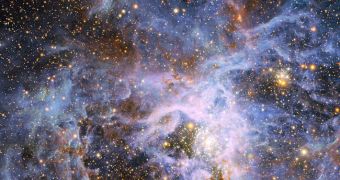An international astronomical collaboration managed to discover one of the brightest, most luminous stars in the entire Universe. The object, dubbed VFTS 682, lies in the dwarf galaxy Large Magellanic Cloud, and is around 300 million times brighter than our Sun.
While finding super-bright stars is nothing new for astronomers, what is puzzling them about this one is the fact that it does not reside in a star cluster. Usually, these are the places where you could expect to find this type of objects.
But the recent study reveals that VFTS 682 is entirely alone, without any similar companions. The star's name, VFTS, is an abbreviation of the VLT-FLAMES Tarantula Survey, a research led by UK Astronomy Technology Center expert Christopher Evans.
The Very Large Telescope (VLT), which is managed in Chile by the European Southern Observatory (ESO), was used for the new investigation too. The data obtained with the instrument throw experts even farther in the dark.
There are currently two possible explanations for the existence of this star – it was either formed inside a star cluster and then rejected in deep space, or it formed in isolation in its current configuration.
Regardless of which of the variants turns out to be true, experts say that the discovery puts a dent in our understanding of how stars form. The new study was conducted using the Fiber Large Area Multi-Element Spectrograph (FLAMES) instrument on the VLT.
With it, experts calculated that VFTS 682 is about 150 times more massive than the Sun. Again, this is highly unusual for a star outside a stellar cluster. Objects this massive tend to have very short lives, of only a few hundred million years.
“We were very surprised to find such a massive star on its own, and not in a rich star cluster. Its origin is mysterious,” explains the lead author of the new study, Armagh Observatory student Joachim Bestenlehner.
The object can be found in the LMC Tarantula Nebula, one of the most analyzed features in our neighboring galaxy. It was found at the core of a massive stellar nursery, an area that spawns new stars at a rapid rate.
It's real brightness level was established after experts compensated for the light being absorbed by the thick layers of cosmic dust that surround it. Surface temperatures have been calculated to reach as much as 50,000 degrees Celsius.
“The new results show that VFTS 682 is a near identical twin of one of the brightest superstars at the heart of the R 136 star cluster,” explains team member Paco Najarro, who is based at CAB (INTA-CSIC, Spain).
“It seems to be easier to form the biggest and brightest stars in rich star clusters. And although it may be possible, it is harder to understand how these brilliant beacons could form on their own. This makes VFTS 682 a really fascinating object,” team member Jorick Vink concludes.

 14 DAY TRIAL //
14 DAY TRIAL //